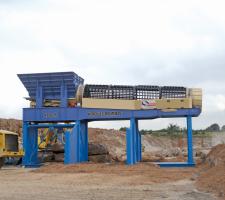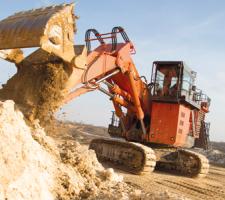
Demand for good-quality stone has risen in recent years and operators are still looking to maximise their potential reserves in order to make their operations both economic and profitable. Although much of the UK quarrying industry, along with others in Europe, is currently suffering from the effects of the economic downturn, restrictions on the opening of new quarries and the development of existing sites has meant that matching production to demand has become a challenging balancing act.
Companies are now looking at the often vast hidden reserves of waste which were left behind as the quarrying of more easily accessible good rock became the prime objective.
As good quality rock reserves become less abundant, new methods for both cleaning and sizing have been developed to capitalise on these material assets.
The development of the heavy duty trommel screen has been at the forefront of this recent trend and has resulted in very high recovery rates of good, clean rock from waste overburden.
This in turn, has helped quarry companies to increase their operating profits, says
Trommel screens have been in use since mechanised quarrying began in the late 18th century when the screens consisted of circular steel meshes bolted together to form a single barrel, which rotated around a long central shaft set at a slight inclination.
Crushed material travelling through the barrel was graded out according to the size of the apertures making up the cylinders. These screens were used extensively until the 1950s, when vibrating flat-bed versions started to appear on the market.
The development of bigger, more robust, high-capacity trommels in the 1980s, largely for the production of rip-rap and armour-stone, paved the way for heavy duty trommels purpose-built to handle high tonnages of material and very large lump sizes. “The tumbling action within the barrel breaks up any unwanted clays to produce a clean product. The barrel itself is self-cleaning and the entire unit works without a permanent operator,” says the company.
Aperture sizes in the barrel are selected to suit the individual customer’s project requirements.
As well as cleaning dirty and contaminated feed materials, trommels have been used for taking out fines prior to crushing. Other duties include the high-volume production of sea/river defence rock and sized material used for gabion baskets to support road and rail cuttings.
Quarry demonstration
During a recent extended demonstration at a major quarrying company site in the UK, a Hercules HT182M mobile trommel was used to process heavily contaminated waste material to recover clean stone that existed within it.
The waste had amassed millions of tonnes over a number of years and was a product of previous quarry extensions along with continued areas of dirty feed material within the quarry face.
The quarry was rapidly running out of space within the waste area and this would have an impact on valuable areas for further excavation work in the future.
“The feed material in the quarry is notoriously sticky in wet conditions and during the period of the demonstration the weather was particularly bad with long periods of heavy rain. The versatility of the
“The barrel apertures on the trommel were selected to suit the customer’s project requirements and were also suitable to cope with the demanding feed material.
“A gabion-sized barrel section was also introduced to add a new product for the customer to generate extra sales revenue.”
The trommel was fed with an existing excavator that was already on site at a rate of up to 500tonnes/hour, and the rejected material and clean stone were removed from under the trommel using loading shovels. The oversize material off the end of the trommel was dropped over the existing bench and allowed to build up until removed by loading shovel when required.
During the demonstration an accurate record was made of the daily weather conditions; where the feed material was located within the waste pile; the throughput of the trommel and the recovery percentage achieved. Calculations were also made on the costs for blasting, royalties, loading and hauling and fuel costs.
“It was quickly apparent that a significant saving could be made in many areas with the trommel in place.”
For example, reduced fuel costs for mobile plant; reduced haulage costs with less mobile plant movements, leading to less mobile plant being required on site; planned quarry extensions suspended, giving extended life to the quarry; less pressure on other crushing/screening plant within the quarry as the stone reaching the plant is not contaminated, leading to improved reliability; and new products produced by the trommel giving extra sales revenue.
Various locations were used within the vast waste pile to select the feed material for the demonstration. Some of these locations had seen the feed material sitting in that same location for many years, which made the contamination very compact, especially lower down where finer material has washed through.
“Even with the heavy rain during the demonstration the trommel coped well with the difficult feed material and excellent recovery rates of over 60% were recorded,” says Stelex.
“This recovery would have been almost impossible by any other current method.
“The amount of unwanted waste material returning to the waste pile after passing through the trommel was greatly reduced and further working of the waste pile would result in more quality stone being recovered and more room on the quarry floor as the waste pile is reduced.”
The existing waste pile could be worked on for many months to come and as a result the possible planned quarry extensions may be put on hold which would result in further cost savings from expensive planning applications.
The clean gabion was removed from under the trommel and made available for immediate sale as a new product for the quarry, while the clean oversize material off the end of the trommel will be sent to the primary crusher without the additional problem caused by the contamination.
This will help to prevent future breakdowns and allow the rest of the plant to be much more efficient and reliable.
“The increasing requirement to reclaim and recycle a greater proportion of primary rock, and the need to clean materials containing heavy contamination, will ensure that heavy duty trommels will continue to play a major role in these projects worldwide for many years come.”
Restoration at Romont
Deep in a chalk quarry in eastern Belgium, a new
It is helping to enhance site productivity and is also a key part of the company’s environmental responsibilities.
It has been working at the 30 hectare site, alongside the village of Eben-Emael in the Liège province of Belgium’s Wallonia region, since January 2013.
CBR, part of the
Romont was opened in 1974 to exploit the marl deposits, which consist of a lime-rich mudstone with variable amounts of clay and silt. The current licence expires in 20 years, but CBR is hoping to extend this agreement for another 40 years.
The total layer of aggregate materials extends to an area of 550 hectares, with 230 million tonnes of chalk available for extraction. The project is situated on high-quality farmland and will result in soil of at least the same quality.
The site’s biodiversity has not been neglected and is the subject of biological studies. Areas of ecological interest are already present and will be partially maintained. The goal is to restore a landscape of high agricultural quality and richer in natural elements than it was prior to its exploitation as a quarry.
CBR’s agreement with the local authorities requires the levelling of mineral waste (overburden) on the floor of the quarry. This is covered with a minimum layer of 30cm of topsoil and the rehabilitated farmlands are then ploughed and fertilised, before being restored for cultivation. At the end of this process the land is returned to the farming community.
An ecological study has also demonstrated the potential of some of the area generated by the quarrying activities. The floor of the quarry is used for nesting by the Little Ringed Plover and the Northern Lapwing also nests on the fallows and the bottom of the quarry.
Ditches draining the reconstituted farmland and their banks shelter the natterjack toad, which finds soft soil and puddles necessary for its preservation. Forestation has also been developed with the aim of facilitating the development of small groves.
In addition, CBR considers its immediate environment by employing direct digging over blasting.
The site’s close vicinity to Eben-Emael; licence restrictions for quarrying the area; and the demand for separated materials, also contribute to this method of extraction and the decision to invest in the new ultra-large excavator.
“CBR needed a new 200tonne excavator and there were four main options to choose from,” says Samuel Wittemans, manager of CBR’s Romont Quarry.
“There were seven people involved in the decision-making process for the new machine. In my opinion, the Hitachi EX1900-6 offered the best compromise for cost, support service and technical specification.
“The size of the bucket was an important factor and Hitachi proposed one of the largest options. The other criteria included the engine power and cost of ownership.”
CBR utilises two dump trucks to work with the EX1900-6 during the extraction process and the excavator makes five passes per load.
“The machine is actually contributing to a higher level of production than expected and so we may need a larger dump truck in the future,” says Samuel.
“It’s not the biggest available bucket, but we sacrificed the size in favour of the power required for direct digging and durability to withstand the rigours of the site.”
A wear package was fitted to the 11m3 20tonne Hitachi bucket and it consists of four tonnes of additional steel for wear plates and other components. This is designed to handle the hard and abrasive materials being extracted, particularly the flint at the bottom of the quarry.
The EX1900-6 has been moving a height of 12-15m (to suit the reach of the excavator) of overburden from the top of the quarry. When combined with the other ultra-large excavator on the site, it will help to extract 3 million tonnes of materials/year: 2.2million tonnes of chalk materials for the Lixhe plant and 800,000tonnes of overburden for the restoration work.
In addition to Samuel and his assistant manager, there are 24 personnel, and it takes them seven shifts to deposit 50,000 tonnes of extracted materials from the quarry and one week for these to be consumed within the production process.
The EX1900-6 is the biggest Hitachi excavator in Belgium, whose quarrying sector is not a significant market for this class of machine. The scale of other operations would normally require a Hitachi ZX870LCH-5 or EX1200-6.
However, this is one of the largest quarries in the country and the 200tonne machine is well suited to the method of extraction, says Hitachi.
Patrick Claeys is
The EX1900-6 was transported on seven trucks from HCME’s headquarters in Amsterdam, The Netherlands, to Romont in October 2012. Assembly work, with a crew of five people from Lucykx and a rented crane, took four days.















